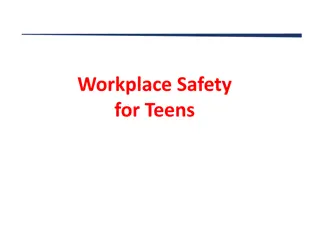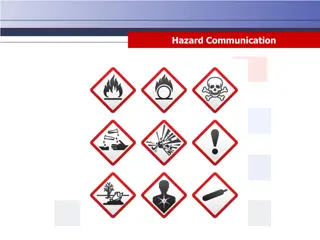Workplace Safety: Protecting Yourself from Coronavirus
Learn about employer and worker responsibilities under the Occupational Safety and Health Act to provide a safe work environment amidst the COVID-19 pandemic. Explore global COVID-19 case locations, understand the risks, and find out how to stay informed and prepared for potential changes in the situation.
Download Presentation

Please find below an Image/Link to download the presentation.
The content on the website is provided AS IS for your information and personal use only. It may not be sold, licensed, or shared on other websites without obtaining consent from the author. Download presentation by click this link. If you encounter any issues during the download, it is possible that the publisher has removed the file from their server.
E N D
Presentation Transcript
Protecting Yourself From Coronavirus in the Workplace Safety and Health Awareness for Responders to the Coronavirus http://www.flu.gov/outreach/h1n1.html March 2020
Employer and worker responsibilities Employers and workers have responsibilities under the OSH Act. The Occupational Safety and Health Act requires that employers provide a safe and healthful workplace free of recognized hazards and follow OSHA standards. Employers responsibilities also include providing training, medical examinations and recordkeeping. Workers must follow the employer s safety and health rules and wear or use all required gear and equipment; follow safe work practices for your job, as directed by your employer; report hazardous conditions to a supervisor; and may report hazardous conditions to OSHA if employers do not fix them.
Locations with Confirmed COVID-19 Cases Global Map As of 12:00 p.m. ET March 10, 2020 Global case numbers are reported by the World Health Organization (WHO) in their coronavirus disease 2019 (COVID-19) situation reportexternal icon. For U.S. information, visit CDC s COVID-19 in the U.S.
How bad could it get? That this disease has caused severe illness, including illness resulting in death is concerning, especially since it has also shown sustained person-to-person spread in several places. These factors meet two of the criteria of a pandemic. As community spread is detected in more and more countries, the world moves closer toward meeting the third criteria, worldwide spread of the new virus.
Risk For the majority of people, the immediate risk of being exposed to the virus that causes COVID-19 is thought to be low. There is not widespread circulation in most communities in the United States. People in places where ongoing community spread of the virus that causes COVID-19 has been reported are at elevated risk of exposure, with increase in risk dependent on the location. Healthcare workers caring for patients with COVID-19 are at elevated risk of exposure. Close contacts of persons with COVID-19 also are at elevated risk of exposure. Travelers returning from affected international locations where community spread is occurring also are at elevated risk of exposure, with increase in risk dependent on location.
What can we do? BE informed BE prepared BE ready to adapt if: COVID-19 increases its ability to cause death and serious illness (virulence) COVID-19 becomes more wide spread There is a shortage of Personal Protective Equipment
The response to COVID-19 needs to be guided by the precautionary principle When it comes to worker safety, we should be driven by the precautionary principle that reasonable steps to reduce risk should not await scientific certainty about the nature of the hazard or risk.
Module 1: COVID-19 Basics
The coronavirus disease 2019 by the novel SARS-COV-2 virus Novel - not seen before Spreads easily Little if any immunity in humans
COVID-19 is spread from person to person mainly through coughing or sneezing Contact -Touching something with COVID-19 virus on it and then touching mouth, nose or eyes Droplet - respiratory secretions from coughing or sneezing landing on mucosal surfaces (nose, mouth, and eyes) Airborne - Breathing in infectious COVID-19 particles - Aerosol (under Droplet) a solid particle or liquid droplet suspended in air (or another gas), even temporarily.Cal/OSHA ATD standard.
COVID-19 causes familiar flu symptoms Most common symptoms include: Fever Cough Shortness of breath Severe sicknesses and deaths have also resulted from illness associated with this virus. Other symptoms may include: Sore throat Runny or stuffy nose Body aches Headache Chills Fatigue
COVID-19 poses a greater risk for people with underlying health conditions Heart disease Lung disease Diabetes Asthma Suppressed immune systems Special population, such as pregnant women and children, at this time are not considered high risk of developing serious COVID-19 illness, but are at increased risk of severe illness from other infectious diseases.
Seasonal flu and COVID-19 are different COVID-19 has the potential to cause more deaths and hospitalizations COVID-19 has caused greater disease in older people and people with underlying health conditions
Pandemic influenzas have happened before and will likely could appear again Three pandemics killed millions of people worldwide in the last century 1918 between 40 and 100 million 1957 2 million 1968 1 million
Vaccine ??? Vaccine currently does not exists to fight Covid- 19, but it is being worked on. Test kits are still being developed and distributed to identify Covid-19 infections
Certain groups will be given priority for vaccination against H1N1 CDC's Advisory Committee on Immunization Practices (ACIP) recommends* the vaccine be given first to: Pregnant women Household contacts and caregivers for children younger than 6 months of age Healthcare and emergency medical services personnel All people from 6 months through 24 years of age Persons aged 25 through 64 years who have health conditions associated with higher risk of medical complications from influenza *http://www.cdc.gov/h1n1flu/vaccination/acip.htm
Module 2: Assessing the Risk of Exposure to COVID-19 in the Workplace
The risk of exposure to COVID-19 at work is related to Whether the type of setting you work in requires close proximity to people potentially infected with the coronavirus, and Whether your specific job duties require you to have close, repeated or extended contact with known or suspected sources of coronavirus
OSHA has classified workplaces into four categories of risk for pandemic influenza http://www.osha.gov/Publications/influenza_pandemic.html
Very High exposure risk occupations are those with high potential exposure to high concentrations of known or suspected sources of COVID-19 during specific medical or laboratory procedures Examples of work settings health care laboratories autopsy suites Examples of job activities bronchoscopy sputum induction working with specimens in laboratories some dental procedures some autopsy procedures
High Exposure risk occupations have a high potential for exposure to known or suspected sources of coronavirus Examples of work settings hospitals and other types of health care facilities medical transport correctional facilities drug treatment centers homeless shelters home health care Examples of job activities direct patient care emergency medical services housekeeping and maintenance in patient areas
Medium risk jobs involve high-frequency contact with the general population Examples of work settings schools outpatient health care social services high density of coworkers high volume retail or other contact with the general public Examples of job activities classroom instruction aiding clients serving customers
Lower exposure risk occupations are those that do not require contact with people known to be infected, nor frequent contact with the public
The level of risk to employees in a health care or other type of facility depends on their exposure to known or suspected sources of COVID-19 resulting from their job duties Setting Job Activities Perform or present during procedures that produce aerosols (bronchoscopy, sputum induction) Provide care to known or suspected patients (bedside care) Health care High frequency contact with general public but not to known or suspected source (cafeteria) Minimal contact with public (office)
Emergency services and critical infrastructure must be able to function during a pandemic Emergency services and critical infrastructure include: law enforcement emergency response public utilities
Keeping critical infrastructure and key resources operating is a priority Government Facilities Dams Commercial Facilities Nuclear Power Plants Critical Infrastructure Food and Agriculture Public Health and Healthcare Banking and Finance Chemical and Hazardous Materials Defense Industrial Base Water Energy Emergency Services Information Technology Telecommunications Postal and Shipping Transportation National Monuments and Icons
Delete pageContact with swine does not pose a serious threat of H1N1 in people at this time H1N1 could spread in the future through contact with infected pigs or environments contaminated with H1N1 flu virus Cannot catch H1N1 from eating pork
Delete page Pigs can get swine flu Signs of flu in pigs can include any of the following: sudden onset of fever lethargy, lack of alertness going off feed (poor appetite) coughing (barking) discharge from the nose or eyes, eye redness or inflammation sneezing breathing difficulties
Module 3: Methods to Prevent COVID-19 Exposure in the Workplace
Basic hygiene and social distancing steps that apply to every workplace Stay home when sick Wash hands or use sanitizer frequently Avoid touching your nose, mouth & eyes Cover coughs & sneezes with tissues or sleeve Dispose of tissues in no-touch bins Wash hands or use sanitizer after coughing, sneezing or blowing nose Avoid close contact with coworkers and customers Avoid shaking hands/wash hands after physical contact with others
Basic hygiene and social distancing steps that apply to every workplace (continued) If wearing gloves, wash hands after removing Keep common surfaces (such as telephones, keyboards, etc) clean Avoid using other workers equipment if possible Minimize group meetings by using phone, email, etc., and avoid close contact when meetings are necessary Limit unnecessary visitors to the workplace Maintain your physical and emotional health with rest, diet, exercise and relaxation
COVID-19 planning should be integrated into an existing safety and health system Management leadership and employee participation Hazard identification and assessment Hazard prevention and control Education and training System evaluation and improvement Plan for a pandemic with increased severity CDC recommends planning for current severity and increasing severity
Use methods that protect workers, starting with the most effective Engineering controls Work practices Administrative controls Personal protective equipment
Engineering controls include Ventilation Drive through service Plastic shields and other barriers
Engineering Controls for Very High and High-risk Jobs Engineering controls for very high and high risk workers include: negative pressure isolation rooms biological safety cabinets
Work practices and administrative practices can reduce workers exposures Work practices to reduce COVID-19 exposure include: hand washing/sanitizer no-touch trash cans cough/sneeze etiquette limiting the number of staff present for very high or high risk tasks training
Adjust policies to reduce exposures Policies that can help to reduce exposure to COVID-19 include: Encouraging workers who are ill to stay home without fear of reprisals or loss of pay or benefits Using email, phone, teleconferences instead of face-to-face contact
Personal protective equipment (PPE) includes Gloves Face shields Respirators Protective clothing
The use of personal protective equipment must comply with OSHA Standards OSHA Standard 1910.132 has general requirements that employers must follow for PPE: Assess workplace for hazards that require the use of PPE Select the correct type of PPP for the hazards Ensure that PPE fits each wearer
Respirators are needed when there is a risk of airborne transmission A N95 respirator is the minimum level of protection to prevent inhaling COVID-19
There are reusable respirators that provide greater protection than disposal respirators Powered air- purifying respirator (PAPR) Half or full-face elastomeric respirators
Surgical masks are not respirators Surgical masks do not: Fit tightly against the skin to form a seal Filter tiny particles, such as viruses or bacteria that are in the air
Respiratory protection must comply with all elements of OSHA Standard 1910.134 Written program Selection hazard to match hazard Medically fit to wear Fit testing Ensure proper use of respirators Respirator maintenance Labeling/color coding filters Employee training Program evaluation Recordkeeping
Personal protective equipment for Very High and High risk jobs include: Face/eye protection Gloves Gowns Respirators at least N95 PAPR or full face elastomeric for greater protection
Other OSHA standards apply to COVID-19 response actions OSHA logo
The hazard communication standard (1910.1200) is a worker s right to know about chemicals OSHA s Hazard Communication Standard (1910.1200) requires: list of all hazardous chemicals in the workplace labels on containers chemical information sheets (material safety data sheets) training written program on how to inform workers
Portable containers must usually be labeled Exception: portable containers do not have to be labeled if only the worker who transfers the chemical uses it during that shift
OSHAs Bloodborne Pathogens Standard (1910.1030) prevents other infections Bloodborne pathogens means diseases that are spread through contact with blood and other body fluids containing blood Bloodborne illnesses include, but are not limited to: HIV/AIDS Hepatitis B Hepatitis C
The Bloodborne Pathogens Standard requires measures to prevent exposure to blood and body fluids Treat all blood and fluids that might contain blood as infectious standard precautions Use safety needles and sharps to prevent cuts Put all used needles and sharps in sharps containers Provide hepatitis B vaccination Use gloves, face shields and other PPE Record needlesticks and sharps injuries
California OSHA issued an Aerosol Transmission Disease (ATD) Standard http://www.dir.ca.gov/Title8/5199.html The standard applies to many types of health care settings, facilities receiving persons from uncontrolled releases of hazardous substances, police services, correctional facilities, drug rehab centers, homeless shelters, and other settings The standard requires different types of engineering controls, work practices and administrative controls, and PPE depending on the level of exposure risk























